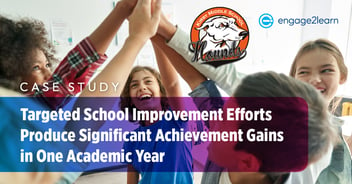"Why are we learning this?"
From kinder through high school, students give us 20,000 hours of their lives. It’s no surprise they eventually start asking, “Why are we learning this?”
That’s actually a valid question! Authenticity helps students find relevance in their learning. Learning becomes authentic when they apply knowledge in real-life contexts and situations, such as through connections to their community or careers.
Students are typically much more motivated to learn the necessary content, and work on quality solutions or products, when the audience is real or the work has a purpose. Learners are more motivated if it is not just for a grade. They often know how to creatively link discrete learning to solve problems in unique ways that adults or professionals immersed in the problems are not able to see.
The roadblock educators often run into is the connection between the standards for mastery and the authentic application of those standards. As a coach, I often hear, “I don’t have time to take that extra step of making it authentic.” I understand those pressures. But that extra step can actually be the one thing, that by doing, will make everything else easier. When students are engaged, attendance increases, behavior issues decrease, and the outcomes data begins to rise.
When designing for authentic learning, start early. Begin by selecting a cluster of standards students will master in your scope and sequence.
Then ask yourself these questions:
- Who could benefit from this information?
- How could the application of this content help someone, solve a problem, meet a challenge, enter a competition, etc.
- How does this content connect to current events, careers, the community, etc.
Resources for finding authentic connections:
- The news: local nightly, national, and world
- Your district and city museums and other educational establishments
- National or state holidays, awareness days, and honor days
- Local, state, national, global politicians and leaders
- Competitions and contests
- Charitable organizations, churches, non-profits including The Red Cross, Habitat for Humanity, homeless shelters, food banks, animal shelters, etc.
- Professionals you know, friends, and family
- Small businesses in the community as well as large businesses
- Student interests
- Virtual audiences, social media, dosomething.org
- Youth Service America
Real-world examples include:
- High School Physics in Community ISD: How can we demonstrate physics principles to raise awareness on the dangers of texting and driving, and promote safe driving in the Toyota Teen Video Challenge?
- Algebra I at Harts Bluff Schools: What would you recommend Harts Bluff Outdoor Education class grow in the spring, based on prices of purchasing the produce at the grocery store?
- 8th grade science at Young Jr. High in Arlington ISD: How can we use knowledge of atmospheric science to accurately forecast weather, and how can we use that forecast to predict when the Arlington Night Shelter should have extended open hours?
- 7th grade math at West MS in Ponca City PS: How can we use operations and rational numbers to determine how much would it cost to treat our awesome staff to popcorn and cold drinks? How much of the ingredients would we need for 75 staff members?
- 6th grade science and ELA at South Park MS in Corpus Christi ISD: In honor of the National Wildlife Federation’s Endangered Species Day, how can we educate South Park Middle School about your selected endangered species and persuade them that it is most critical for adoption?
- 4th/5th grade science at Prestwick STEM in Little Elm ISD: Our school is looking to create an outdoor learning environment that will include natural vegetation and wildlife. How can your team create a local ecosystem for our outdoor learning environment?
- 4th grade math at Kostoryz ES in Corpus Christi ISD: In our neighborhood there is a requirement that dogs must be kept in an enclosed fence (dog pen) in the backyard when they are outside. How can we use area and perimeter to design dog pens that are appropriately sized for different dogs?
- 4th grade social studies: How can we inform and persuade our school district to celebrate Indigenous People’s Day, instead of Columbus Day?
- 3rd grade math: How can we collect data and create graphs that show which meals students like most and least, to help our cafeteria manager plan the lunch menu?
- 2nd grade ELA: How can we use our writing skills to help the elderly in our community not be so lonely?
- 1st grade science, ELA: How can we persuade and help our teacher apply for the Pets in the Classroom Grant?
-
Kindergarten social studies at Hidden Lakes ES in Keller ISD: How can we use our knowledge of needs and wants to create a business providing a good or service for our school?
Designing for authentic learning is a creative challenge, and the more you practice the better you get. Pro Tip: reach out to your peers and colleagues for ideas or connections; they will make your ideas even better!
When students see the purpose from the start of the unit, they stop asking “Why am I learning this?” and start asking, “How can I solve this problem?”



